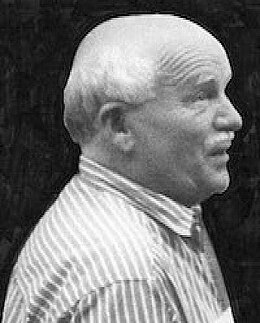
Louis de Niverville, born in 1933 in Andover, England, was one of thirteen children in a family that would become an integral part of Canada's cultural fabric. His father, Air Vice-Marshal Albert de Niverville of the Royal Canadian Air Force, moved the family to Montreal in 1934, just a year after Louis's birth. This relocation marked the beginning of Louis de Niverville's lifelong connection to Canada, where he would develop into one of the country's most distinctive artistic voices.
From a young age, de Niverville showed a precocious talent for drawing, with his early works leaning heavily towards representational art. However, as he moved into his middle teens, his interests began to shift toward more humorous and whimsical depictions, signaling the early stages of what would become his signature style.
In 1953, the de Niverville family moved to Ottawa, where his father took up a position with the Department of Transport. This change in environment did not dampen Louis's artistic ambitions. Instead, he found encouragement and inspiration in the vibrant cultural scene of the capital, particularly in the realms of amateur theatre and design. His involvement with the Ottawa Little Theatre, where he worked on set designs and advertisements, was a pivotal experience. It was here that he met Stan White, an architect and director of amateur theatricals, and Paul Arthur, a freelance art director and designer. Both men played crucial roles in nurturing de Niverville's burgeoning talent.
De Niverville's big break came in 1957 when Paul Arthur encouraged him to showcase his portfolio to various art directors in Toronto. This leap of faith paid off, as he soon found work with Mayfair magazine and was eventually hired by the CBC graphics department under the leadership of David Mackay. His portfolio even contributed to an animated film, "The Pounding Heart," produced by Mackay and Warren Collins. The film, a surrealistic and plotless eight-minute short, was lauded for its originality and the unique visual flair that de Niverville brought to it. This early success solidified his reputation as a fresh and innovative force in the Canadian art scene.
Throughout the 1960s and 1970s, de Niverville's work evolved, delving deeper into the themes of dreams and nightmares. His exhibitions during this period, particularly at the Jerrold Morris Gallery, revealed a darker, more introspective side of his creativity. Critics noted that his paintings, often populated by eerie figures and surreal landscapes, evoked a sense of mystery and unease. Even in his earlier, more whimsical works, there was a "vague element of threat," as one reviewer pointed out.
De Niverville's artistic influences were eclectic. He drew inspiration from American cartoonists like Saul Steinberg and James Thurber, whose works are known for their wit and whimsy. At the same time, his paintings also bore the influence of French masters Henri Matisse and Pierre Bonnard, particularly in their vibrant use of color and form. This blend of influences resulted in a body of work that was both visually striking and intellectually engaging, challenging viewers to look beyond the surface and explore the deeper meanings within.
His contributions to the Canadian art scene were not limited to his paintings. De Niverville also made a significant impact through his mural work, completing major commissions for institutions such as the Ontario Architecture Building Centre and the Toronto International Airport. His murals, much like his paintings, were characterized by their surreal, dreamlike quality, transforming ordinary spaces into realms of imagination and wonder.

De Niverville's work was widely exhibited, with solo shows at prestigious galleries such as the Gallery of Contemporary Art, Here & Now Gallery, Dorothy Cameron Gallery, and Jerrold Morris Gallery, among others. He also participated in several group shows, including the notable "Surrealism in Canadian Painting" exhibition at the London Public Library and Art Museum. His paintings are held in numerous public and private collections, including those of the University of Western Ontario, McMaster University, and the Agnes Etherington Art Centre.
Despite his success, de Niverville remained a deeply introspective and private individual. His later works continued to explore the darker aspects of the human experience, reflecting his own complex inner world. Yet, even in his most haunting pieces, there was always a sense of hope, a glimpse of light amidst the shadows.
Louis de Niverville's legacy is one of innovation and introspection. His ability to blend humor with horror, whimsy with darkness, and reality with fantasy made him a unique and invaluable figure in Canadian art. Through his paintings, murals, and illustrations, he offered viewers a glimpse into his own dreamscapes, inviting them to journey with him into the depths of imagination and beyond
Browse our collection of Canadian paintings for sale at the Canadian Classic Fine Art gallery, The best place to buy a painting online. We provide free shipping anywhere in Canada and the United States. Our Montreal art gallery sells paintings online exclusively and have a 14 days return policy.
